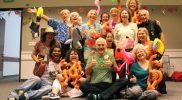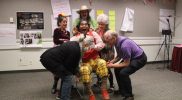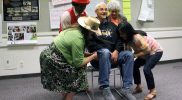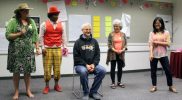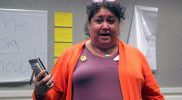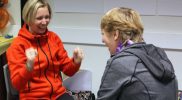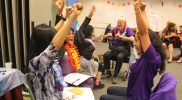Unconferences are participant-driven event built on Open Space Technology, a natural communication process that ensures that what is important to each participant are discussed. This format creates space for peer-to-peer learning, collaboration and creativity.
- From the well thought out pre-prepared talk reflecting years of research and practice to the spur of the moment ‘new idea’ that would be fun to talk about.
- From the demonstration of a working tool to the white-boarding of something completely new.
Before the event
Think about what you would like to learn, the questions you would like to ask, or the topics you are passionate about that you would like to share with others.
Feel free to start discussions on the conference Facebook page. Although you’ll see suggestions for sessions and talking about ideas ahead of time there, note that this is not where the agenda gets created. That happens at the event itself.
Convening a session
- Anyone may call for a topic, however, if you do then you are expected to have the passion to be responsible enough to start the discussion on it. You also must make sure that a report of the discussion is done so that any participant can access the content of the discussion at all times.
- Ask for help holding the space if you need it. You might, for example, put a session on the board and know that you are so passionate about the topic that it would be better if someone else, someone more objective, facilitates the discussion.
- Don’t assume people in the room know more, or less, than you do. You never know who is going to be interested in your session. You might want to start by asking people to hold up their hands if they’ve been involved with the topic for more than five years, for one to five years, or for one year or less.
- Don’t feel that you have to “fill” up an hour of time. If what you have to say only takes 15 min and the group has finished interacting–then the session can end.
- Don’t feel pressure to have everything take “only” an hour. If you start with a short presentation, and then a group conversation gets going, and your discussion needs to continue past an hour – find a way to make this happen. You might be able to keep talking for a while, or move to another part of the conference area, or post “Part 2” on the agenda.
- Don’t be upset if only two people show up to your session. Those two people are the ones who share your interest.
Choose a format for your session will help you achieve your vision!
There is no ‘right way’ to lead a session. However there is a bias towards interaction and discussion. Here are a few ideas about different session types to get you thinking about possibilities.
ONE PERSON TALKS
- Innovator Studio: Leader or audience interview and Q/A session with an innovator.
- The longer formal presentation: This is tricky, because it’s difficult to make a formal presentation interactive. But if you have a big, well-developed idea you can pull it off.
- Show and tell : You have a cool project, a demo, or just something to show and let people play with that is the springboard for all the conversation in the session. Alternatively, everyone takes a turn showing how they do X.
- The round: Person A interviews person B, person B interviews person C, and so on and so forth until you circle back to person A.
Show and tell:
ONE PERSON LEADS
- Hypothetical: The leader poses hypothetical situations to the participants to hear how their ideas and theories may be applied in practical application.
- Spectrogram: There is a tape on the floor with agree at one end and disagree at the other. The leader asks a somewhat controversial question and directs participants to take a stand on the spectrum, then interviews people about the opinions they hold.
- Learn how to do X: If you’re inclined to teach, this can be simple and effective. Bring the equipment that you need, and have a plan that will let you teach five, ten, or 15 people how to do something all at the same time.
GROUP DYNAMICS
- My Big (or Little) Question: You have a question you want to know the answer to, and you think others in the group could help you answer it. This format could also just be the seed of a conversation.
- TED talks: 5-15 minutes of prepared material or comments by the session leader followed by an interactive discussion.
- Witnessed conversations: 2-4 discussants on a topic. Instead of facing an audience in a row with a moderator, however, the discussants sit in a circle with the audience in a concentric circles around them.
Advice about leading a session
- Collaboration among participants who convene sessions and even merging of sessions on similar topics are both encouraged. If you convene a session, the decision to merge with another session will always be yours to make.
- If you convene a session, it is your responsibility to “hold the space” for your session. You hold the space by leading a discussion, by posting a “first question,” or by sharing information about your program. Be the shepherd – stay visible, be as involved as necessary, be a beacon of sanity that guides the group.
- Ask for help holding the space if you need it. You might, for example, put a session on the board and know that you are so passionate about the topic that it would be better if someone else, someone more objective, facilitates the discussion. Choose someone from your team, or another participant who is interested in the topic.
- Don’t assume people in the room know more, or less, than you do. You never know who is going to be interested in your session. You might want to start by asking people to hold up their hands if they’ve been involved with the topic for more than five years, for one to five years, or for one year or less.
- Don’t be upset if only two people show up to your session. Those two people are the ones who share your interest.
- Don’t feel that you have to “fill” up an hour of time. If what you have to say only takes 15 min and the group has finished interacting–then the session can end. At the start of the conference, we will discuss guidelines for how this can happen.
- Don’t feel pressure to have everything take “only” an hour. If you start with a short presentation, and then a group conversation gets going, and your discussion needs to continue past an hour – find a way to make this happen. You might be able to keep talking for awhile in the room you are in, or move to another part of the conference area, or post “Part 2” on the agenda At the start of the conference, we will discuss guidelines for how this can happen.
- Be Brave! Others are interested in making your session work!
- Do think about the ideas that you want to cover in your session, and how you want to cover them. But don’t feel as though you need to prepare a great deal. (If you’re over-prepared, your session might lose energy.)
- Experiment with the kind of sessions you lead. There is no such thing as “failure” an an unconference.
Criteria making a topic inappropriate
- There is no real question or uncertainty about how to do what’s being discussed.
- The session leaders and/or sponsors believe they already know the answer(s) and are looking for ways to sell or impose those ideas on everybody else.
- The session leaders and/or sponsors believe that they are the only ones entitled to or able to comment.
- The session leaders and/or sponsors are seeking the appearance of participation, but are unwilling or unable to deal openly and directly with high passion or concern, increasing complexity, real diversity of people or opinions, and/or the urgent need to make decisions and take action.
If nobody shows up to your session then you have several options
- Use the session as free time to think the issue through and record your thoughts as a contribution to the proceedings
- Join another discussion on a related topic and see if they’re open to joining topics with you.
- Drop the topic altogether. If so you must indicate on your post how you resolved no one showing up so that the session has been accounted for.
Important!
Unconferences have four rules, one law (the law of two feet), two types of insects and a coffee/tea area 🙂
FOUR RULES
- Whoever come are the right people
- Whatever happens is the only thing that could have.
- Whenever it starts is the right time.
- When it’s over, it’s over
The Law of Two Feet states that: “If, during the course of the gathering, any person finds themselves in a situation where they are neither learning nor contributing, they can go to some more productive place.”
TWO TYPES OF INSECTS
- Butterflies: These people hang out, maybe drinking tea, and don’t appear to do much. However they may just be involved with the most important discussions of the day.
- Bees: They flit from conversation to conversation bring new ideas, and fresh eyes to the table. They can also encourage mingling for those for whom the Law of Two Feet feels a bit rude.
Advice for everyone at the All America Laughter Unconference
- Go with the flow – This event is intended to help you and all the other grantees find the time and space to talk with and learn from each other.
- Follow your passion – Go to the sessions that interest you.
- Take responsibility for your own learning – If there are topics you are really interested in that don’t appear on the agenda at first, you need to put them on there.
